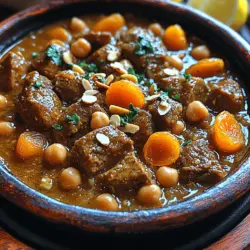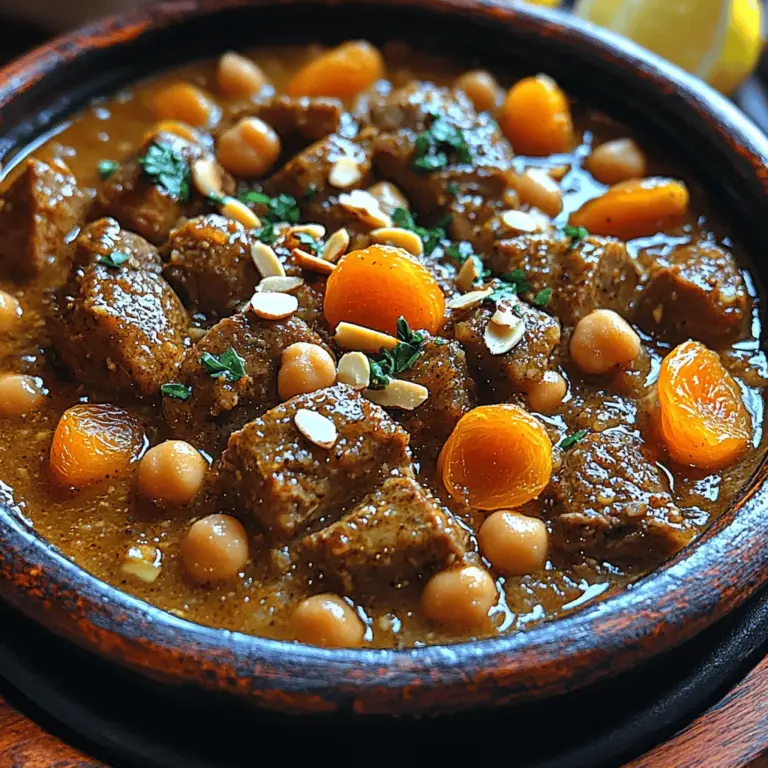Introduction
Welcome to the captivating world of Moroccan cuisine, where fragrant spices and rich flavors intertwine to create dishes that are as vibrant as the culture itself. One standout dish that encapsulates the essence of Moroccan cooking is the Exotic Moroccan Lamb Tagine. This slow-cooked stew, traditionally prepared in a conical clay pot known as a tagine, is characterized by its tender lamb, aromatic spices, and a medley of fruits and vegetables. As you delve into this recipe, you will discover not only the delightful taste it offers but also its significance and appeal across diverse culinary traditions.
The importance of tagine dishes in Moroccan cuisine cannot be overstated. They are often served during special occasions and family gatherings, symbolizing hospitality and the sharing of food among loved ones. The tagine is not merely a cooking vessel; it represents a communal experience, bringing people together around the table. With its roots deeply embedded in North African culture, the Lamb Tagine has transcended regional boundaries, captivating food lovers around the globe with its unique combination of flavors and textures.
This recipe promises to appeal to a wide audience, from seasoned home cooks to culinary novices eager to explore new flavors. The Exotic Moroccan Lamb Tagine is not only a feast for the palate but also an opportunity to experience the rich tapestry of Moroccan history and tradition through food. Whether you are looking to impress guests at a dinner party or simply wish to treat yourself to a comforting meal, this dish is sure to satisfy.
What Makes This Recipe Special
Unique Flavor Profiles
What sets the Exotic Moroccan Lamb Tagine apart is its complex flavor profile. The dish typically features a harmonious blend of spices such as cumin, coriander, cinnamon, and saffron, each contributing to a depth of flavor that is both warm and inviting. The slow cooking process allows these spices to meld together, infusing the lamb and vegetables with an aromatic essence that is uniquely Moroccan. Additionally, the inclusion of sweet elements, such as dried apricots or prunes, balances the savory notes, creating a dish that is truly multifaceted.
Nutritional Benefits
Not only is Lamb Tagine an explosion of flavor, but it also offers several nutritional benefits. Lamb is a rich source of high-quality protein, essential vitamins, and minerals such as iron and zinc. When combined with an array of vegetables like carrots, onions, and bell peppers, the dish becomes a well-rounded meal that provides a variety of nutrients. The use of spices like turmeric and ginger also adds anti-inflammatory properties, making this dish not only delicious but also beneficial for your health.
Cultural Significance or History of the Dish
The tagine cooking method has been used for centuries, with origins tracing back to ancient Berber tribes of North Africa. Traditionally, the tagine pot was essential for cooking stews over a fire, allowing for slow braising and the development of rich flavors. As a result, the Moroccan Lamb Tagine has become a staple not only in Moroccan households but also in restaurants worldwide, representing the warm, communal spirit of Moroccan dining. Each family may have its interpretations and variations of the recipe, often passed down through generations, making it a cherished dish in many households.
Versatility in Serving Options
The Exotic Moroccan Lamb Tagine excels in versatility, making it suitable for various occasions. It can be served as a hearty main course alongside fluffy couscous, crusty bread, or fragrant rice, allowing diners to soak up the flavorful sauce. Alternatively, it can be presented in smaller portions as part of a larger Moroccan feast, accompanied by an array of mezze dishes. The dish can also be easily adapted for dietary preferences, making it a great choice for gatherings with diverse palates.
Ingredients Overview
To create the perfect Exotic Moroccan Lamb Tagine, you will need a selection of high-quality ingredients. Below is a detailed list of the main components, along with an explanation of each ingredient’s role in the recipe.
Main Ingredients
1. Lamb Shoulder or Leg: The star of the dish, lamb shoulder or leg provides the rich flavor and tenderness needed for a hearty tagine. These cuts benefit from slow cooking, resulting in meat that is succulent and falls off the bone.
2. Onions: Onions form the aromatic base of the dish, providing sweetness and depth when sautéed. They help build the foundation of flavors alongside the spices.
3. Garlic: Minced garlic adds a punch of flavor that complements the spices and enhances the overall aroma of the dish.
4. Carrots: Carrots bring natural sweetness and vibrant color to the tagine, balancing the savory elements.
5. Canned Tomatoes: These provide a rich, tangy sauce for the dish, helping to create a luscious consistency. Fresh tomatoes can also be used in place of canned.
6. Dried Apricots or Prunes: These dried fruits add a delightful sweetness, balancing the spices and creating a unique flavor contrast.
7. Spices: A blend of cumin, coriander, cinnamon, paprika, and saffron is essential for achieving the distinct Moroccan flavor. Each spice plays a crucial role in creating the dish’s aromatic complexity.
8. Olive Oil: Used for sautéing the vegetables and browning the meat, olive oil adds richness to the dish.
9. Chicken or Vegetable Broth: This liquid is used to braise the ingredients, enhancing flavor and ensuring the meat remains moist throughout the cooking process.
Optional Ingredients and Variations
– Chickpeas: For added protein and texture, chickpeas can be included in the tagine, making it even heartier.
– Other Vegetables: Feel free to experiment with seasonal vegetables such as zucchini or bell peppers to add variety.
– Herbs: Fresh herbs like cilantro or parsley can be used as a garnish to brighten the dish before serving.
– Spice Variations: Depending on your preference, you can adjust the spices or even add new ones like ginger or turmeric for a different flavor profile.
Tips for Sourcing High-Quality Ingredients
To ensure your Exotic Moroccan Lamb Tagine is as flavorful as possible, sourcing high-quality ingredients is essential. Here are some tips:
– Lamb: Look for locally sourced, grass-fed lamb from a reputable butcher or farmer’s market. The quality of the meat will greatly impact the dish’s overall flavor.
– Spices: Opt for fresh spices rather than pre-ground versions, as they will provide a more vibrant flavor. Visit a local spice shop or international grocery store for the best selection.
– Produce: Choose fresh, organic vegetables whenever possible. They not only taste better but also contribute to a healthier dish.
– Dried Fruits: Select unsweetened dried fruits without added preservatives to maintain a natural flavor.
Preparation Steps
Preparing the Exotic Moroccan Lamb Tagine is a rewarding experience that allows you to engage with each ingredient fully. The following step-by-step guide will walk you through the initial preparation of the dish, ensuring you are well-equipped to create a masterpiece in your kitchen.
Step 1: Gather Your Ingredients
Before you begin cooking, ensure you have all the necessary ingredients on hand. This will streamline the preparation process and make it easier to follow the recipe.
Step 2: Prepare the Lamb
– Cut the Lamb: If you are using a whole shoulder or leg, cut it into large chunks (about 2 inches thick). This size allows for even cooking and ensures the meat remains tender.
– Marinate: While not strictly necessary, marinating the lamb in a mixture of olive oil, garlic, and spices for at least 1 hour (or overnight, if time permits) will enhance the flavor. Combine the lamb with minced garlic, cumin, coriander, paprika, and a drizzle of olive oil in a bowl. Mix well, cover, and refrigerate.
Step 3: Chop the Vegetables
While the lamb marinates, chop your vegetables:
– Onions: Dice the onions finely, as they will form the aromatic base of the dish.
– Carrots: Peel and slice the carrots into thick rounds or half-moons for a hearty texture.
Step 4: Prepare the Spices
Measure out your spices ahead of time to keep your cooking organized. A good rule of thumb is to use:
– 2 teaspoons of cumin
– 2 teaspoons of coriander
– 1 teaspoon of paprika
– 1 teaspoon of cinnamon
– A pinch of saffron (if using)
Step 5: Time Management Tips
To optimize your cooking experience, consider the following time management tips:
– Prep Ahead: Whenever possible, prepare your ingredients ahead of time. Chopping vegetables and marinating meat can be done a few hours before cooking.
– Use a Timer: Set timers for each cooking stage to avoid overcooking or missing steps.
Step 6: Start Cooking
Once your ingredients are prepped, you can begin the cooking process.
1. Sauté the Onions: In a large tagine pot or Dutch oven, heat 2 tablespoons of olive oil over medium heat. Add the diced onions and sauté until they become translucent and fragrant, about 5-7 minutes.
2. Add the Lamb: Increase the heat to medium-high and add the marinated lamb chunks. Brown the meat on all sides, about 4-5 minutes per side, sealing in the juices and enhancing the flavor.
3. Incorporate the Spices: Once the lamb is browned, add the measured spices to the pot. Stir well to coat the meat and onions, allowing the spices to toast for about 1 minute.
4. Add the Remaining Ingredients: Pour in the canned tomatoes, broth, and dried fruits. Bring the mixture to a gentle simmer, ensuring all ingredients are well combined.
5. Cover and Cook: Reduce the heat to low, cover the pot with the lid, and let the tagine cook slowly for about 1.5 to 2 hours. This slow cooking method allows the flavors to meld beautifully while keeping the lamb tender.
Cooking Techniques
The cooking techniques employed in preparing the Exotic Moroccan Lamb Tagine are critical for achieving the desired texture and flavor.
Overview of Cooking Methods
The primary cooking methods used in this recipe are sautéing and slow braising. Sautéing the onions and browning the lamb at the beginning develops a rich flavor base, while slow braising allows the ingredients to simmer together, creating a harmonious blend of tastes.
Temperature Control and Timing
Maintaining the right temperature is crucial for this dish. Start with medium-high heat to brown the lamb and onions, then reduce to low heat for the braising phase. This ensures that the meat cooks evenly without becoming tough. The tagine should be covered during the simmering process to trap steam and moisture, resulting in tender meat.
Tips for Achieving the Best Texture and Flavor
– Don’t Rush the Process: Allowing the tagine to cook slowly is key to developing deep flavors. Resist the urge to increase the heat for quicker cooking.
– Check for Doneness: The lamb should be fork-tender when done. If it’s not, allow it to simmer for additional time.
– Taste and Adjust: Before serving, taste the sauce and adjust seasoning as needed. A pinch of salt or a splash of lemon juice can elevate the dish further.
By following these steps and techniques, you’re well on your way to creating a remarkable Exotic Moroccan Lamb Tagine that is sure to impress and satisfy. As you prepare this dish, you will not only be cooking a meal but also participating in a rich culinary tradition that celebrates the art of flavorful, communal dining. Enjoy the journey into Moroccan cuisine and the delightful experience of preparing this exotic dish!


